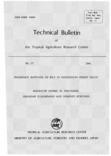Phosphate response of rice in Indonesian paddy fields
国名
インドネシア
Technical bulletin of the Tropical Agriculture Research Center
| ISSN | 03889394 |
|---|---|
| 書誌レコードID(総合目録DB) | AA00857848 |

本文フルテキスト
techtarc17-_1-85.pdf16.5 MB
MIYAKE, M., ISMUNADJI, M., ZULKARNAINI, I. and ROECHAN, S., 1984, Phosphate response of rice in Indonesian paddy fields
Tech. Bull., Trop. Agr. Res. Center, Japan, No. 17
Twelve Indonesian, mainly paddy soils, were compared with six Japanese soils and their characteristics were analysed by physical and chemical methods. The soils were divided into four groups according to their phosphate sorption coefficient and various soil parameters such as CEC and contents of clay, free iron, exchangeable Ca and organic carbon. To evaluate the phosporus availability of paddy soil by using soil testing methods, wet or submerged samples of soils should be extracted, because the availability of phosphorus is greatly influenced by submergence.
Among the soil testing methods applied to the submerged soils, Bray II method showed a highly significant correlation with P uptake by rice seedlings grown on soils except for neutral and alkaline soils rich in Ca-P. The Olsen-EDTA method consisting of extraction with 0.5 M NaHCO3-0.02 M EDTA at pH 8.5 was proposed by the authors since it was found to be applicable to a wider range of paddy soils. Pot and field experiments with various soils were carried out to determine the effect of phosphate application on the growth and yield of rice plants. Although a remarkable response to phosphate was observed in the tillering capacity of rice plants grown in a Reddish Brown Latosol, no significant yield differences were recognized among the phosphate levels applied. The amount of phosphate required to produce a unit weight of rice grain was nearly the same as that for temperate rice.
Severe phosphorus deficiency occurred in the newly opened paddy fields with Red-Yellow Podzolic soil. The amount of phosphate application recommended for such fields was estimated to be 100 kg/ha, with which the critical Bray II-P value of 15 ppm P can be maintained in the soil.
Phosphates in the solid phase of Grumusol or a soil rich in calcium phosphate become available when the pH decreases after submergence. Application of 20 kg P2O5/ha of readily soluble phosphate is recommended to compensate for the phosphorus deficiency in the early growth stage of rice plants in such soils. In Java, most of the Regosols and Alluvial soils derived from pyroclastic materials are rich in phosphate. Phosphate application is not necessary in those soils which have a high content of total and available phosphate.
Tech. Bull., Trop. Agr. Res. Center, Japan, No. 17
Twelve Indonesian, mainly paddy soils, were compared with six Japanese soils and their characteristics were analysed by physical and chemical methods. The soils were divided into four groups according to their phosphate sorption coefficient and various soil parameters such as CEC and contents of clay, free iron, exchangeable Ca and organic carbon. To evaluate the phosporus availability of paddy soil by using soil testing methods, wet or submerged samples of soils should be extracted, because the availability of phosphorus is greatly influenced by submergence.
Among the soil testing methods applied to the submerged soils, Bray II method showed a highly significant correlation with P uptake by rice seedlings grown on soils except for neutral and alkaline soils rich in Ca-P. The Olsen-EDTA method consisting of extraction with 0.5 M NaHCO3-0.02 M EDTA at pH 8.5 was proposed by the authors since it was found to be applicable to a wider range of paddy soils. Pot and field experiments with various soils were carried out to determine the effect of phosphate application on the growth and yield of rice plants. Although a remarkable response to phosphate was observed in the tillering capacity of rice plants grown in a Reddish Brown Latosol, no significant yield differences were recognized among the phosphate levels applied. The amount of phosphate required to produce a unit weight of rice grain was nearly the same as that for temperate rice.
Severe phosphorus deficiency occurred in the newly opened paddy fields with Red-Yellow Podzolic soil. The amount of phosphate application recommended for such fields was estimated to be 100 kg/ha, with which the critical Bray II-P value of 15 ppm P can be maintained in the soil.
Phosphates in the solid phase of Grumusol or a soil rich in calcium phosphate become available when the pH decreases after submergence. Application of 20 kg P2O5/ha of readily soluble phosphate is recommended to compensate for the phosphorus deficiency in the early growth stage of rice plants in such soils. In Java, most of the Regosols and Alluvial soils derived from pyroclastic materials are rich in phosphate. Phosphate application is not necessary in those soils which have a high content of total and available phosphate.
| 刊行年月日 | |
|---|---|
| 作成者 | Masanori Miyake M.ISMUNADJI Iskandar ZULKARNAINI Sismiyati ROECHAN |
| 著者キーワード | phosphorus in soil phosphorus fertilizer phosphorus deficiency in soil soil test values |
| 公開者 | Tropical Agriculture Research Center |
| 巻 | 17 |
| 開始ページ | 1 |
| 終了ページ | 85 |
| 言語 | eng |
